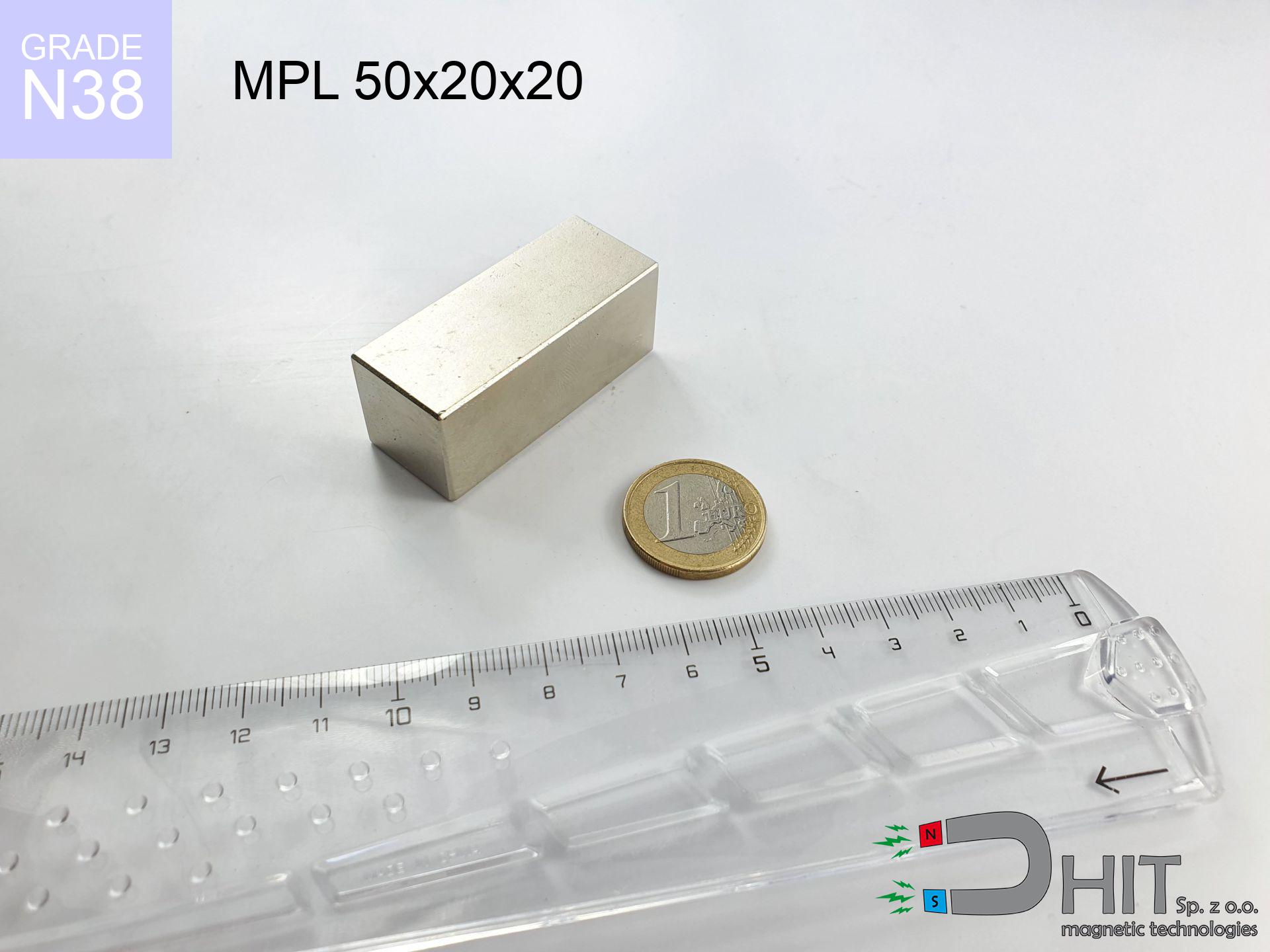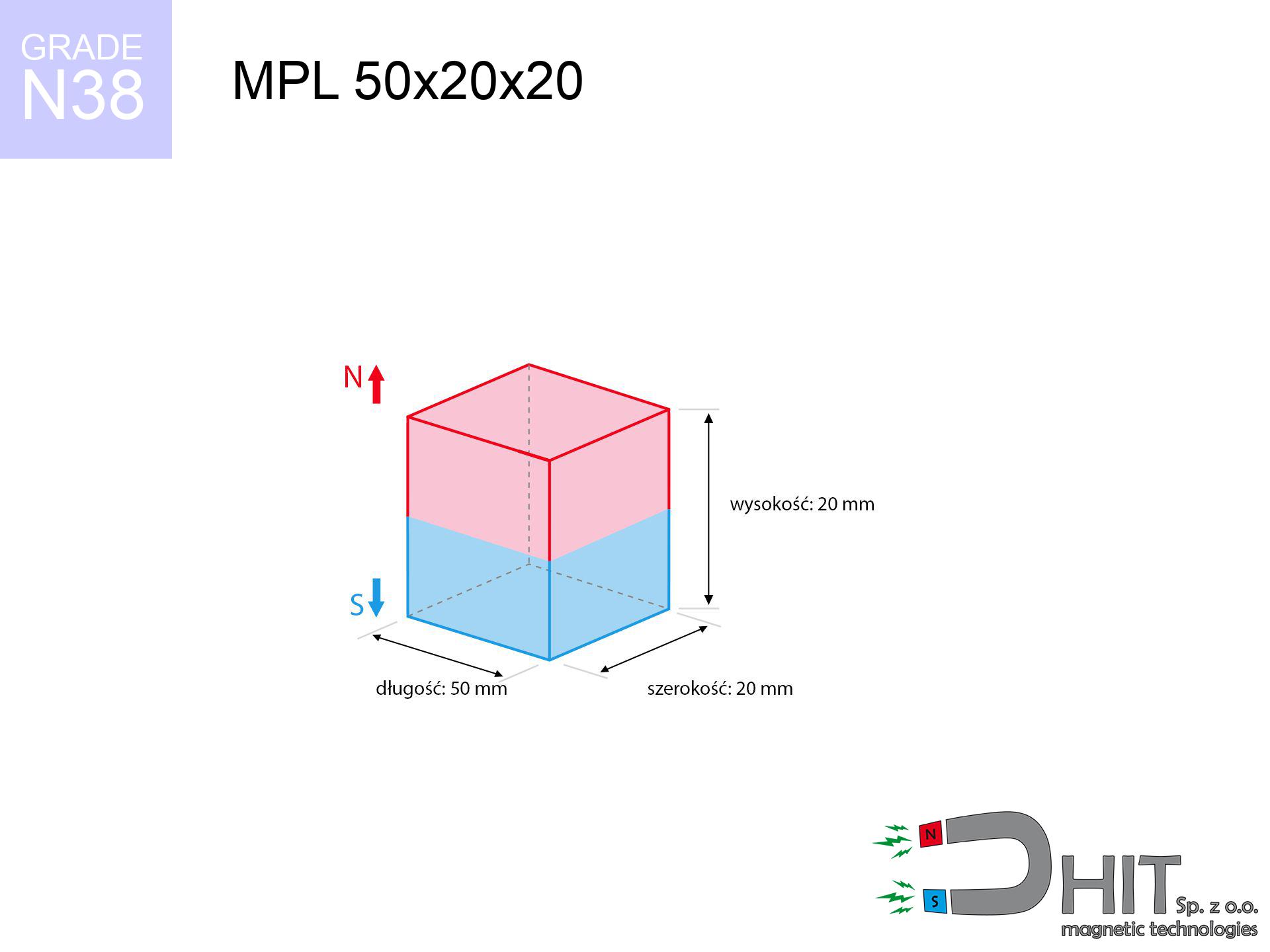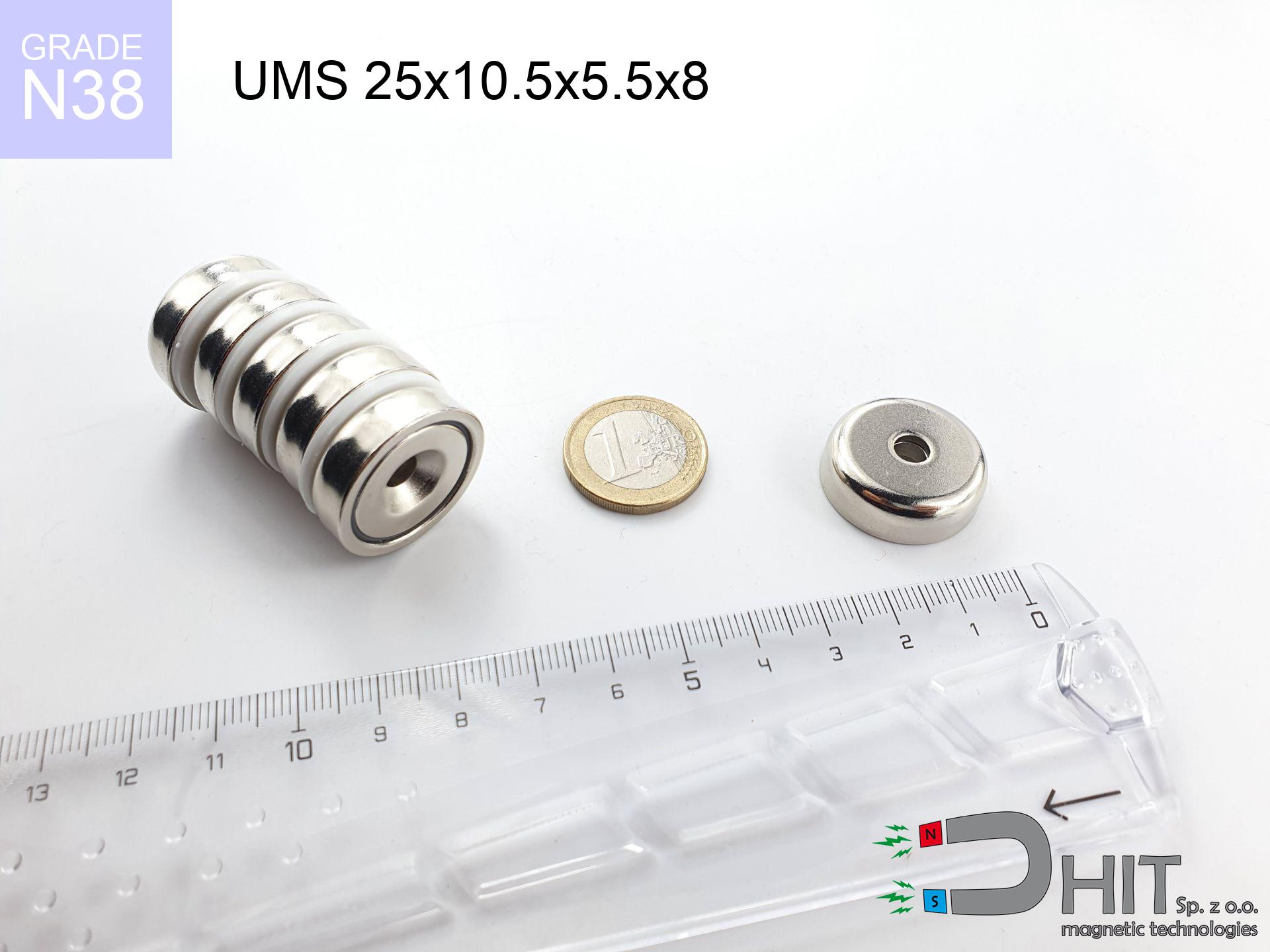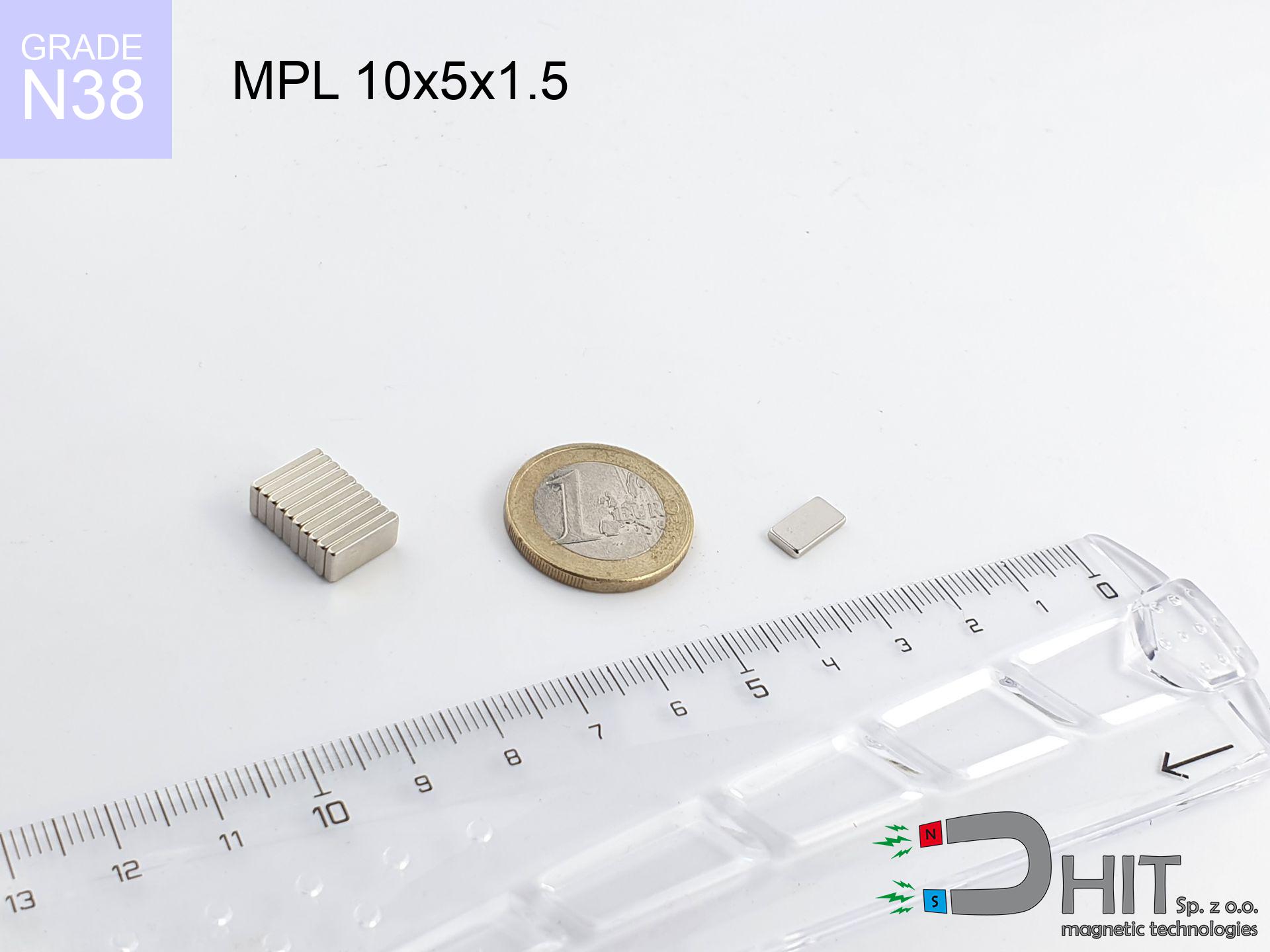MPL 50x20x20 / N38 - lamellar magnet
lamellar magnet
Catalog no 020166
GTIN: 5906301811725
length [±0,1 mm]
50 mm
Width [±0,1 mm]
20 mm
Height [±0,1 mm]
20 mm
Weight
150 g
Magnetization Direction
↑ axial
Load capacity
49.94 kg / 489.74 N
Magnetic Induction
478.99 mT
Coating
[NiCuNi] nickel
49.00 ZŁ with VAT / pcs + price for transport
39.84 ZŁ net + 23% VAT / pcs
bulk discounts:
Need more?Want to negotiate the price?
Call us +48 22 499 98 98 or write via form on the contact page. Test the magnet's power with our power calculator.
Orders placed by 14:00 are shipped the same day.
MPL 50x20x20 / N38 - lamellar magnet
Magnetic properties of material N38
Physical properties of NdFeB
Shopping tips
Thanks to their mighty power, flat magnets are frequently applied in structures that need very strong attraction.
Most common temperature resistance of flat magnets is 80°C, but depending on the dimensions, this value can increase.
Moreover, flat magnets commonly have special coatings applied to their surfaces, e.g. nickel, gold, or chrome, to increase their corrosion resistance.
The magnet named MPL 50x20x20 / N38 i.e. a magnetic force 49.94 kg weighing just 150 grams, making it the perfect choice for projects needing a flat magnet.
Contact surface: Due to their flat shape, flat magnets guarantee a greater contact surface with other components, which can be beneficial in applications requiring a stronger magnetic connection.
Technology applications: These are often used in different devices, e.g. sensors, stepper motors, or speakers, where the thin and wide shape is necessary for their operation.
Mounting: Their flat shape simplifies mounting, particularly when there's a need to attach the magnet to some surface.
Design flexibility: The flat shape of the magnets permits creators a lot of flexibility in placing them in structures, which can be more difficult with magnets of more complex shapes.
Stability: In some applications, the flat base of the flat magnet may offer better stability, reducing the risk of sliding or rotating. It’s important to keep in mind that the optimal shape of the magnet depends on the specific application and requirements. In some cases, other shapes, such as cylindrical or spherical, are more appropriate.
Magnets have two main poles: north (N) and south (S), which interact with each other when they are oppositely oriented. Poles of the same kind, e.g. two north poles, act repelling on each other.
Due to these properties, magnets are regularly used in electrical devices, such as motors, speakers, sensors, or magnetic locks. Neodymium magnets stand out with the greatest strength of attraction, making them indispensable for applications requiring powerful magnetic fields. Additionally, the strength of a magnet depends on its dimensions and the material it is made of.
It’s worth noting that extremely high temperatures, above the Curie point, cause a loss of magnetic properties in the magnet. Every magnetic material has its Curie point, meaning that once this temperature is exceeded, the magnet stops being magnetic. Interestingly, strong magnets can interfere with the operation of devices, such as navigational instruments, credit cards or medical equipment, like pacemakers. For this reason, it is important to avoid placing magnets near such devices.
Advantages and disadvantages of neodymium magnets NdFeB.
In addition to immense strength, neodymium magnets have the following advantages:
- They do not lose their strength (of the magnet). After about 10 years, their strength decreases by only ~1% (theoretically),
- They are highly resistant to demagnetization by external magnetic sources,
- Thanks to the shiny finish and nickel, gold, or silver coating, they have an aesthetic appearance,
- They have very high magnetic induction on the surface of the magnet,
- Thanks to their high temperature resistance, they can operate (depending on the form) even at temperatures up to 230°C and above...
- Due to the option of accurate forming or adaptation to individual needs – neodymium magnets can be produced in many variants of shapes and sizes, which enhances their versatility in applications.
- Key role in the industry of new technologies – are used in HDD drives, electric motors, medical devices or various technologically advanced devices.
Disadvantages of neodymium magnets:
- They are prone to breaking as they are fragile when subjected to a strong impact. If the magnets are exposed to impacts, we recommend using magnets in a steel housing. The steel housing in the form of a holder protects the magnet from impacts and also increases its overall strength,
- They lose power at high temperatures. Most neodymium magnets experience permanent loss of strength when heated above 80°C (depending on the shape and height). However, we also offer special magnets with high temperature resistance, up to 230°C,
- Magnets exposed to a humid environment can corrode. Therefore, when using them outdoors, we suggest using waterproof magnets made of rubber, plastic, or other moisture-resistant materials,
- The use of a cover or a magnetic holder is recommended due to the limited possibilities of manufacturing threads or complex shapes in the magnet
- Health risk arising from small pieces of magnets pose a threat, when accidentally ingested, which is crucial in the context of child safety. It's also worth noting that tiny parts of these magnets can be problematic in medical diagnosis after entering the body.
Be Cautious with Neodymium Magnets
Neodymium magnets can become demagnetized at high temperatures.
Although magnets are generally resilient, their ability to retain their magnetic strength can be influenced by factors like the type of material used, the magnet's shape, and the intended purpose for which it is employed.
Under no circumstances should neodymium magnets be brought close to GPS and smartphones.
Magnetic fields interfere with compasses and magnetometers used in navigation for air and sea transport, as well as internal compasses of smartphones and GPS devices.
Neodymium magnets are the strongest, most remarkable magnets on earth, and the surprising force between them can surprise you at first.
Familiarize yourself with our information to properly handle these magnets and avoid significant injuries to your body and prevent damage to the magnets.
If you have a nickel allergy, avoid contact with neodymium magnets.
Studies clearly indicate a small percentage of people who suffer from metal allergies such as nickel. An allergic reaction often manifests as skin redness and rash. If you have a nickel allergy, try wearing gloves or avoid direct contact with nickel-plated neodymium magnets.
Do not place neodymium magnets near a computer HDD, TV, and wallet.
Strong magnetic fields emitted by neodymium magnets can destroy magnetic storage media such as floppy disks, credit cards, magnetic ID cards, cassette tapes, video tapes, or other devices. In addition, they can damage televisions, VCRs, computer monitors, and CRT displays. You should especially avoid placing neodymium magnets near electronic devices.
Neodymium magnets should not be in the vicinity youngest children.
Neodymium magnets are not toys. Do not allow children to play with them. Small magnets can pose a serious choking hazard. If multiple magnets are swallowed, they can attract to each other through the intestinal walls, causing severe injuries, and even death.
Neodymium magnets can attract to each other, pinch the skin, and cause significant swellings.
If joining of neodymium magnets is not under control, at that time they may crumble and also crack. You can't approach them to each other. At a distance less than 10 cm you should have them very firmly.
Neodymium magnetic are especially delicate, resulting in shattering.
Neodymium magnetic are fragile as well as will crack if allowed to collide with each other, even from a distance of a few centimeters. They are coated with a shiny nickel plating similar to steel, but they are not as hard. At the moment of connection between the magnets, small sharp metal fragments can be propelled in various directions at high speed. Eye protection is recommended.
Dust and powder from neodymium magnets are highly flammable.
Do not attempt to drill into neodymium magnets. Mechanical processing is also not recommended. Once crushed into fine powder or dust, this material becomes highly flammable.
Keep neodymium magnets away from people with pacemakers.
Neodymium magnets produce strong magnetic fields that can interfere with the operation of a heart pacemaker. However, if the magnetic field does not affect the device, it can damage its components or deactivate the device when it is in a magnetic field.
Exercise caution!
To illustrate why neodymium magnets are so dangerous, read the article - How dangerous are strong neodymium magnets?.






![SM 25x350 [2xM8] / N52 - magnetic separator SM 25x350 [2xM8] / N52 - magnetic separator](https://cdn3.dhit.pl/graphics/products/sm-25x350-2xm8-geb.jpg)


